| dc.description.abstract | Soccer is characterized as a high-intensity sport that combines intermittent bouts of anaerobic and aerobic activities such as jogging, shuffling, short sprints, rapid multi-directional acceleration and decelerations, turning, jumping, kicking, and tackling. Within the context of sports performance, an overarching goal of many teams is to develop and maintain optimal physical fitness throughout the course of the competitive season. In order to achieve this, one must fully understand the general and specific demands of their population’s sport. Therefore, the purpose of this study was to investigate differences in internal and external training loads between 5 phases of a NCAA Division I women’s soccer season. n total, 797 total data points from 80 games were analyzed from the current sample. A two-way Multivariate Analysis of Variance (MANOVA) was performed to analyze the effect of Position and Season Phase on internal and external loads. The MANOVA revealed no statistically significant interactions between the effects of Position and Season Phase on internal and external loads F(168, 5739) = 1.142, p = .103; Wilks' Λ = .781. Simple main effects analyses showed that Position (Defender, Midfielder, Forward) did have a statistically significant effect on internal and external loads F(42, 1524) = 7.694, p = .000; Wilks' Λ = .681. Additionally, large effect sizes were observed for this analysis (ηp2 = 0.175). Simple main effects analysis showed that Season Phase (Exhibition, Non-Conference, Conference, B12, NCAA) did have a statistically significant effect on internal and external loads F(84, 3012) = 3.785, p = .000; Wilks' Λ = .673. Additionally, a moderate effect size was observed for this analyses (ηp2 = 0.094). This study provides insight into the position- and season phase-specific physical demands of NCAA Division I women’s soccer. The findings of this research successfully reconfirmed well-reported positional differences in physical demands. However, the current study has also successfully provided a novel contribution to the field by identifying the statistically significant differences in physical demands between specific phases of the NCAA Division I women’s college soccer season. These findings may serve as a tool for assessing and enhancing current approaches to preparing female athletes for their respectful competitive seasons. | |
